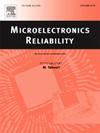不同铝浓度的AlGaN背势垒对AlGaN/GaN hemt捕集机理的影响研究
IF 1.9
4区 工程技术
Q3 ENGINEERING, ELECTRICAL & ELECTRONIC
引用次数: 0
摘要
研究了不同铝浓度对0.45 μm栅极AlGaN/GaN HEMTs短通道和色散效应的影响。测试了四个样品,一个作为参考,没有背垒,但有铁掺杂的GaN缓冲液,三个具有AlGaN背垒,分别含有0.5%,1%和1.5%的铝。与参考器件相比,后势垒器件具有较低的电流崩溃,后者受到铁诱导缺陷和残留c诱导的深能级的捕获的影响。含有1.5% Al的器件显示出与参考器件相当的亚阈值特性,但电流崩溃低50%。1%铝背障器件在掐断条件下显示出非常低的漏源漏出,因此具有最低的色散效应。本文章由计算机程序翻译,如有差异,请以英文原文为准。
Study of trapping mechanisms affecting AlGaN/GaN HEMTs adopting AlGaN back-barriers with different aluminum concentrations
The influence of different Aluminum concentrations in the AlGaN back-barrier on short-channel and dispersion effects of 0.45 μm-gate AlGaN/GaN HEMTs has been studied. Four samples have been tested, one as reference without back-barrier but with a Fe-doped GaN buffer, and three with an AlGaN back-barrier with respectively a 0.5 %, 1 % and 1.5 % Aluminum. Back-barrier devices have lower current collapse with respect to the reference, the latter being affected by trapping at Fe-induced defects and at deep levels induced by residual C. Devices with 1.5 % Al show subthreshold characteristics comparable with those of reference, but 50 % lower current collapse. 1 % Al back-barrier devices show very low drain-source leakage in pinch-off conditions and as a consequence the lowest dispersion effects.
求助全文
通过发布文献求助,成功后即可免费获取论文全文。
去求助
来源期刊

Microelectronics Reliability
工程技术-工程:电子与电气
CiteScore
3.30
自引率
12.50%
发文量
342
审稿时长
68 days
期刊介绍:
Microelectronics Reliability, is dedicated to disseminating the latest research results and related information on the reliability of microelectronic devices, circuits and systems, from materials, process and manufacturing, to design, testing and operation. The coverage of the journal includes the following topics: measurement, understanding and analysis; evaluation and prediction; modelling and simulation; methodologies and mitigation. Papers which combine reliability with other important areas of microelectronics engineering, such as design, fabrication, integration, testing, and field operation will also be welcome, and practical papers reporting case studies in the field and specific application domains are particularly encouraged.
Most accepted papers will be published as Research Papers, describing significant advances and completed work. Papers reviewing important developing topics of general interest may be accepted for publication as Review Papers. Urgent communications of a more preliminary nature and short reports on completed practical work of current interest may be considered for publication as Research Notes. All contributions are subject to peer review by leading experts in the field.
 求助内容:
求助内容: 应助结果提醒方式:
应助结果提醒方式:


